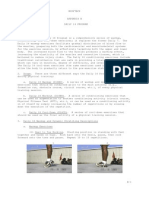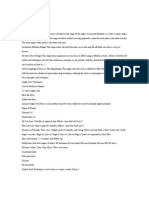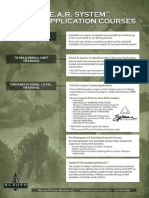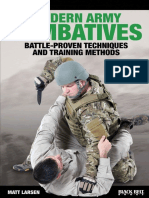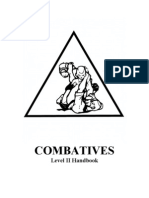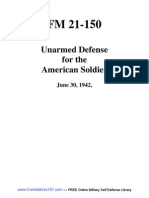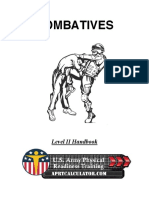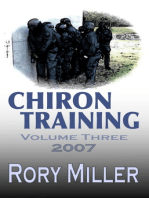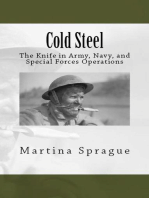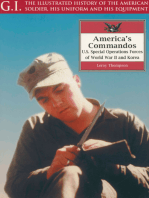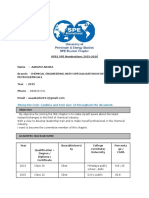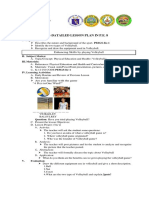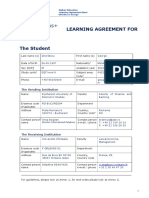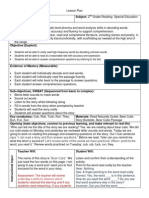Army Combative Poster
Army Combative Poster
Uploaded by
Joe DolioCopyright:
Available Formats
Army Combative Poster
Army Combative Poster
Uploaded by
Joe DolioCopyright
Available Formats
Share this document
Did you find this document useful?
Is this content inappropriate?
Copyright:
Available Formats
Army Combative Poster
Army Combative Poster
Uploaded by
Joe DolioCopyright:
Available Formats
NO Tap-out in Combat Muzzle Thump Post Frame Hook and Head Control
Soldiers must maintain control of the weapon at all times by keeping the enemy at projectile weapons range when possible. Use strikes To execute the Frame, keep feet, hips, chin and weapon positioned simi- Execute the Hook and Head Control by placing the non-firing arm
like the Muzzle Thump to drive an enemy back, keeping him at projectile weapons range. If closer proximity than projectile range is nec- lar to the Post. Extend forearm beyond 90 degrees with fingers spread underneath enemy’s arm with hand cupping the shoulder. Push fore-
essary, use the Post, Frame or Hook and Head Control. To execute the Post, keep feet more than shoulder width apart, turn hips so sec- across enemy’s collarbone or with hand cupping the back of the head. head into enemy’s chin. Legs should straddle enemy’s closest leg.
ondary weapon is away from the enemy, tuck chin, use flat palm with thumb down to push enemy.
Clear Primary Weapon with Strikes Achieve the Clinch Elbow and Knee Strikes Front and Rear Takedowns
From a clinch position, a Soldier may take the enemy to the
ground. When in front of the enemy, drive to tackle. When be-
Strike enemy in the head with the point of your elbow. For additional power, rotate your
Use Strikes to regain control of the weapon. Strike enemy in the face with the heel of the hand. Close with the enemy and gain dominance, especially in case of a weapons hind the enemy, drag him down.
body and pull enemy’s head toward elbow strike. To execute Knee Strike, bring rear
Strike enemy at the hip bone with the bottom of the foot. Push weapon down to clear enemy’s malfunction or if the enemy is attempting to use his own weapon. knee up to strike enemy in gut or head. For additional power, pull enemy’s head down.
arms, and repeatedly strike his head with the Army combat helmet until his grip is broken.
Stand in Base with Projectile Weapon Escape the Mount with Arm Trap and Roll Secondary Weapon
If a Soldier ends up on the ground at projectile weapon range from the enemy, mobility can be regained by returning to the standing position. If a Soldier has failed to maintain his feet and the enemy has gained control of the Soldier’s legs, the Soldier will be forced to fight for a dominate
position, in this case using the Arm Trap and Roll.
Employing a secondary weapon
allows a Soldier to quickly end the
fight but can only be done safely
when the Soldier is in control of the
position.
Modern Army Combatives Program History Basic Combatives is one of the Forty Warrior MACP Course Levels
• 1995 — 2nd Ranger Battalion commander orders reinvigoration of battalion combatives program. Core Tasks of the Warrior Ethos initiative, and Level 1 — Basic Army Combatives Course: 40-hour course teaches basic combatives techniques. Instruc-
• The FM at that time, written in 1992, offered no means to certify or train instructors. all Soldiers should know the following moves: tors for this course should be taught at battalion level by a level 3 instructor and certified by a lieutenant colonel
• Commander appoints a committee to research improving close quarters combat tactics and methods. (O-5) commander. Level 1 qualified instructors can teach the basic combatives drills and tasks.
Muzzle Thump Escape the Mount, Shrimp to the Guard
• Program begins to develop and spread as a grassroots effort as Rangers begin teaching outside the Ranger community.
Tug-of-War Arm Push and Roll to the Rear Mount Level 2 — Tactical Army Combatives Course: 80-hour course tailored to teach advanced techniques, teach-
• 2002 — Army publishes new Combatives FM 3-25.150, which implements curriculum in Initial Military Training and Infantry Officer Palm Heal Strike Escape the Rear Mount ing methodologies and philosophies. Each company will have at least one level 2 qualified instructor. The level
Education system. Kick Rear Naked Choke 2 instructor course is taught at the brigade/installation level by a level 4 instructor and certified by a colonel (O-
• 2005 — U.S. Army Combatives School opens at Fort Benning, Ga. Head Butt Cross Collar Choke from the Mount and Guard 6) commander. Level 2 qualified instructors can supervise level 1 instructors and referee basic competitions.
Post Bent Arm Bar
• 2006 — Soldier’s Manual of Common Tasks includes combatives as one of 40 Warrior core tasks.
Frame Straight Arm Bar Level 3 — Basic Army Combatives Instructor Course: 160-hour course integrates fighting skills into the in-
• 2007 — AR 350-1 delineates training for all units Armywide and every battalion and brigade to have certified instructors. Hook and Head Control Sweep from the Attempted Straight Arm Bar fantry battle drills and close quarters battle. Level 3 qualified instructors can instruct the level 1 course, referee
• 2009 — As Soldier feedback from the field necessitates refinement, FM 3-25.150 is updated with more techniques and outlines Access Secondary Weapons Scissors Sweep post events, special rules competitions and serve as battalion master trainer for scenario-based training.
planning for Armywide instructor training programs. Stand in Base Close the Gap and Achieve the Clinch
Escape the Mount, Trap and Roll Front Takedown to the Mount Level 4 — Tactical Army Combatives Instructor Course: 160-hour course designed to teach management
• 2010 — Soldier feedback leads to MACP broadening the curriculum at lower levels so Basic Combat Training and Advanced
Pass the Guard Rear Takedown skills at the installation level. Instruction focuses on how to design, manage, execute and promote a safe com-
Individual Training teach more fighting techniques to new Soldiers.
Side Control Front Guillotine Choke batives program, with special emphasis on teaching methodologies and safety.
Achieve the Mount from Side Control
j
N
C
Credits: Photos by John D. Helms, Fort Benning PAO; Demonstrators: Soldier — Staff Sgt. Christopher Gordon, Enemy — Sgt. Atreyu Ross, USACS; Design by Sgt. Russel Schnaare; Written by Linda Crippen. Read more about recent changes to the MACP in the August 2010 NCO Journal: https://usasma.bliss.army.mil/NCOJournal/default.asp.
O
You might also like
- Fairbairn Gutterfighting KnifeDocument13 pagesFairbairn Gutterfighting Knifecobeboss0% (1)
- Process and Progress Pistol Training: Proven Methods to Structure Your PracticeFrom EverandProcess and Progress Pistol Training: Proven Methods to Structure Your PracticeNo ratings yet
- Submission Fighting and The Rules of Ancient Greek Wrestling (Pale) - Christopher MillerDocument38 pagesSubmission Fighting and The Rules of Ancient Greek Wrestling (Pale) - Christopher Millerchef_samuraiNo ratings yet
- AR-15 Skills & Drills: Learn to Run Your AR Like a ProFrom EverandAR-15 Skills & Drills: Learn to Run Your AR Like a ProRating: 5 out of 5 stars5/5 (1)
- Life Is Beautiful Script - DoczxcDocument29 pagesLife Is Beautiful Script - DoczxcOutlookRuralHealth0% (1)
- Defensive Revolver Fundamentals, 2nd Edition: Protecting Your Life with the All-American FirearmFrom EverandDefensive Revolver Fundamentals, 2nd Edition: Protecting Your Life with the All-American FirearmNo ratings yet
- USMC Daily 16 Workout ManualDocument20 pagesUSMC Daily 16 Workout Manualth1sisnotmyusername100% (3)
- Modern Defendo History PDFDocument85 pagesModern Defendo History PDFprd67% (3)
- Eric SykesDocument15 pagesEric SykesTarredPigeon100% (1)
- The Palestine Police Force CQB ManualDocument89 pagesThe Palestine Police Force CQB Manualmwhaught100% (2)
- US Marine Corps Daily 16 ProgramDocument12 pagesUS Marine Corps Daily 16 ProgramHip Hop 1919No ratings yet
- Accelerated Battlefield CombativesDocument129 pagesAccelerated Battlefield CombativesSiratal Mustaqim100% (1)
- Spear System Guide NewDocument13 pagesSpear System Guide Newprincegirish100% (3)
- Jeet Kune Do Concept Eskrima Stick Fighting MethodDocument38 pagesJeet Kune Do Concept Eskrima Stick Fighting MethodMuhammad Pasti Lulus100% (4)
- Geoff Thompson - Real Self DefenceDocument11 pagesGeoff Thompson - Real Self DefenceDerrick Shoulders100% (1)
- Structured Self Protection The Game Plan: Beta8 CXTFrom EverandStructured Self Protection The Game Plan: Beta8 CXTRating: 1 out of 5 stars1/5 (1)
- Kasper - 1997 - Can Pragmatic Competence Be TaughtDocument19 pagesKasper - 1997 - Can Pragmatic Competence Be Taughtryanpeters100% (1)
- SPEAR Combat Application CoursesDocument4 pagesSPEAR Combat Application CoursesJPC RADARNo ratings yet
- PDFDocument147 pagesPDFLorenzo Montecinos100% (12)
- MACP LVL 1Document14 pagesMACP LVL 1Hugopal100% (1)
- Knife J J RenaudDocument2 pagesKnife J J Renaudsteelbonnet100% (2)
- Air Crew Self Defense TechniquesDocument21 pagesAir Crew Self Defense Techniquesmwhaught100% (1)
- Combatives: Level II HandbookDocument16 pagesCombatives: Level II HandbookJose Hernandez100% (1)
- Gabe Suarez On Knife FightingDocument2 pagesGabe Suarez On Knife Fightingtkn111100% (4)
- (1942) FM 21-150 Unarmed Defense For The American SoldierDocument75 pages(1942) FM 21-150 Unarmed Defense For The American SoldierSamurai_Chef100% (3)
- A Short History of The GarrotteDocument8 pagesA Short History of The GarrotteJandric Nebojsa-JimmyNo ratings yet
- Unarmed CombatDocument47 pagesUnarmed Combatryankp100% (2)
- Marine Corps Individual Combat Course, July 1944Document9 pagesMarine Corps Individual Combat Course, July 1944shaqtim100% (2)
- Cold Steel Style Vs Put em Down, Take em Out StyleDocument5 pagesCold Steel Style Vs Put em Down, Take em Out StylecmonBULLSHIT100% (2)
- Self-Defense From The Mad Men EraDocument9 pagesSelf-Defense From The Mad Men EraMiguel Omar Pieszko100% (2)
- Winning A High Speed Close Distance GunfightDocument150 pagesWinning A High Speed Close Distance GunfightScott CNo ratings yet
- Combatives: Level II HandbookDocument20 pagesCombatives: Level II HandbookAshleigh AndersonNo ratings yet
- Free Dont Wear Your Gi To The Bar ArtechokepdfDocument164 pagesFree Dont Wear Your Gi To The Bar Artechokepdf1983gonzo100% (1)
- Mcmap Brown BeltDocument156 pagesMcmap Brown Beltnarencz100% (3)
- FM 21-150, Unarmed Defense For The American Soldier, June 30, 1942, Section I, GeneralDocument105 pagesFM 21-150, Unarmed Defense For The American Soldier, June 30, 1942, Section I, Generalisrafeleva1No ratings yet
- Basic Combatives Instructor Course - Level III - POI DCST - 2 - PDFDocument111 pagesBasic Combatives Instructor Course - Level III - POI DCST - 2 - PDFJanne FredrikNo ratings yet
- Master at Arms James A. Keating and Comtech Random Thoughts On Tactics, Knives, Combat and LifeDocument8 pagesMaster at Arms James A. Keating and Comtech Random Thoughts On Tactics, Knives, Combat and Lifemaajak1100% (1)
- Bill Kipp - Turning Fear Into Power - The FAST Defense System-Paladin Press (2005)Document267 pagesBill Kipp - Turning Fear Into Power - The FAST Defense System-Paladin Press (2005)Kenneth SandersonNo ratings yet
- Hans Wurm - 1507Document31 pagesHans Wurm - 1507Christiano Martins Milfont de AlmeidaNo ratings yet
- Classic Strikes Combat Hand To Hand Self DefenseDocument26 pagesClassic Strikes Combat Hand To Hand Self Defensegeacom100% (1)
- Combato PDF UnderwoodDocument2 pagesCombato PDF UnderwoodDawn0% (1)
- Prison Martial Arts & Gang IndocturinationDocument4 pagesPrison Martial Arts & Gang IndocturinationRon Collins100% (3)
- Tomahawk FightingDocument7 pagesTomahawk FightingcmonBULLSHITNo ratings yet
- Uscca Armed Citizen SolutionDocument34 pagesUscca Armed Citizen Solutionbambam42676030No ratings yet
- Close Quarter CombatDocument48 pagesClose Quarter CombatDave Galvez80% (5)
- Fm21-150 Unarmed Defense For The American Soldier 1942Document75 pagesFm21-150 Unarmed Defense For The American Soldier 1942cmonBULLSHITNo ratings yet
- Manual of Savate and English Boxing - The Leboucher MethodDocument29 pagesManual of Savate and English Boxing - The Leboucher Methodjimbobsme100% (3)
- Mud, Guts & Glory: Tips & Training for Extreme Obstacle RacingFrom EverandMud, Guts & Glory: Tips & Training for Extreme Obstacle RacingRating: 4 out of 5 stars4/5 (1)
- Cold Steel: The Knife in Army, Navy, and Special Forces Operations: Knives, Swords, and Bayonets: A World History of Edged Weapon Warfare, #3From EverandCold Steel: The Knife in Army, Navy, and Special Forces Operations: Knives, Swords, and Bayonets: A World History of Edged Weapon Warfare, #3No ratings yet
- The Secrets of Jujitsu - A Complete Course in Self Defense - Book FourFrom EverandThe Secrets of Jujitsu - A Complete Course in Self Defense - Book FourNo ratings yet
- Gun Digest’s IDPA Gear & Concealed Carry Clothing eShort Collection: Massad Ayoob covers concealed carry clothing while discussing handgun training advice, CCW tips & IDPA gear.From EverandGun Digest’s IDPA Gear & Concealed Carry Clothing eShort Collection: Massad Ayoob covers concealed carry clothing while discussing handgun training advice, CCW tips & IDPA gear.No ratings yet
- America's Commandos: U.S. Special Operations Forces of World War II and KoreaFrom EverandAmerica's Commandos: U.S. Special Operations Forces of World War II and KoreaNo ratings yet
- Education System of Peru and AustraliaDocument2 pagesEducation System of Peru and AustraliaNaomi Ishii TairaNo ratings yet
- Aakash Arora Btech Chemical EnggDocument3 pagesAakash Arora Btech Chemical EnggAyush AgarwalNo ratings yet
- Taksonomi SoloDocument30 pagesTaksonomi SoloJessica FongNo ratings yet
- Saravanan ResumeDocument4 pagesSaravanan Resumesarav92No ratings yet
- DRH The Audiolingual MethodDocument68 pagesDRH The Audiolingual MethodSafe Word100% (4)
- Birth Control EssayDocument9 pagesBirth Control Essayapi-319114999No ratings yet
- Grade 9 Maths Textbook CbseDocument3 pagesGrade 9 Maths Textbook CbseNareshNo ratings yet
- Assessment On The Employability SkillsDocument24 pagesAssessment On The Employability SkillsBhenjha Mae RelampagosNo ratings yet
- Lesson Plan in P.E Team Sports VolleyballDocument2 pagesLesson Plan in P.E Team Sports VolleyballNeil DeclaroNo ratings yet
- Marzano and Learning TheoryDocument5 pagesMarzano and Learning TheoryertyuiopNo ratings yet
- Popsicle BridgeDocument12 pagesPopsicle Bridgeavinash35100% (3)
- McDonough C01Document14 pagesMcDonough C01Dharwin GeronimoNo ratings yet
- CV For ITESDocument2 pagesCV For ITESKathryn MayNo ratings yet
- Bridging Teaching-Learning Gaps: Engagement Through TechnologyDocument5 pagesBridging Teaching-Learning Gaps: Engagement Through TechnologyDua QasehNo ratings yet
- ImprovisationDocument21 pagesImprovisationgreesma78% (9)
- Chapter 6 Curriculum Evaluation Hazel 014525Document10 pagesChapter 6 Curriculum Evaluation Hazel 014525Marialyn MoliningNo ratings yet
- Green Point Gazette 3-26-09Document2 pagesGreen Point Gazette 3-26-09jlipson304No ratings yet
- National Council of Teachers of Mathematics Is Collaborating With JSTOR To Digitize, Preserve and Extend Access To The Mathematics TeacherDocument6 pagesNational Council of Teachers of Mathematics Is Collaborating With JSTOR To Digitize, Preserve and Extend Access To The Mathematics TeacherfadzilNo ratings yet
- Learning Agreement For Studies The StudentDocument16 pagesLearning Agreement For Studies The StudentGeorge GhertescuNo ratings yet
- Gladys Ruiz, ResumeDocument2 pagesGladys Ruiz, Resumeapi-284904141No ratings yet
- Math Syllabus 9th GradeDocument2 pagesMath Syllabus 9th Gradeapi-317614387No ratings yet
- Education Pathway BrochureDocument2 pagesEducation Pathway Brochureapi-263357331No ratings yet
- Curriculm VitaeDocument3 pagesCurriculm Vitaeapi-284243420No ratings yet
- Mastery Learning (Or, As It Was Initially Called, "Learning For Mastery") Is An InstructionalDocument2 pagesMastery Learning (Or, As It Was Initially Called, "Learning For Mastery") Is An InstructionalJAGATHESAN100% (1)
- Science Is The Most Important School SubjectDocument2 pagesScience Is The Most Important School SubjectTaha ArshadNo ratings yet
- Course Module EL. 107 Week 1Document27 pagesCourse Module EL. 107 Week 1Joevannie Acera100% (1)
- Updated CV Raymond 2018Document2 pagesUpdated CV Raymond 2018Arip HardiansyahNo ratings yet
- Signature AssignmentDocument4 pagesSignature Assignmentapi-251319366No ratings yet







